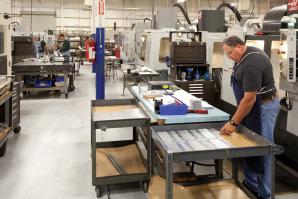In March, the Elk Grove city council voted to develop the last large swath of land in its jurisdiction. But this time around, instead of focusing on rooftops, as the city has for the past decade, leaders and developers hope to bolster the local economy by building new businesses.
After a steady boom in housing followed by a crippling recession, Elk Grove ran out of room to add more commerce, leaving it with a deficit of jobs for its 156,000 residents. The disparity has left many residents commuting to neighboring cities for work, but with the development of the Southeast Policy Area, Elk Grove could increase job opportunities substantially and become known as more than a bedroom community.
The Southeast Policy Area (SPA) encompasses 1,200 undeveloped acres near Whitelock Parkway and Kammerer Road neighboring the partially built Elk Grove Promenade Mall, a retail vision stalled by the recession. For the past 15 years, the area has been eyed for various projects, but once the nearby Laguna Ridge Specific Plan and its nearly 8,000 residences came to fruition, SPA became the sole hope of economic revival.
“It’s been on our radar screen for a while now,” says Mayor Gary Davis, who, along with the city council, has made developing the Southeast Policy Area a major economic priority. Laguna Ridge and many other areas in the city turned into housing developments instead of job centers, leaving Elk Grove residents with just half a job per household, or about 30,000 jobs for roughly 110,000 adults. With the development of the Southeast Policy Area, the number of jobs is forecasted to increase by nearly 27,000.
The vision is to create a sustainable, employment-oriented development to quell the city’s high unemployment rate and accommodate future population growth. A village center equipped with an employment services agency, a supermarket, retail shops, schools and restaurants would be surrounded by 6,000 single-family and multi-family homes. Forty-five percent of the development would be commercial.
“That’s a significant shift from other plan areas in the city,” says Brian Cooley, a project manager with development firm Souza Elk Grove. “For example, the Laguna Ridge plan was 90 percent residential and 10 percent commercial. The shift of 55 to 45 is different for the city and the Sacramento region.”
For connectivity, a Regional Transit route with a bus would be added, followed eventually by light-rail with stops at Cosumnes River College and the Elk Grove Promenade Mall. Though the station’s reality may be 20 years away, the community will have bicycle lanes and pedestrian walkways to cut traffic in the meantime.
Additionally, 120 acres will be devoted to a soccer stadium for the California Storm, the region’s amateur female soccer team that previously played in Folsom. Three more elementary schools are also planned, and conversations are taking place regarding a Los Rios Community College satellite campus.
The Southeast Policy Area has several major landowners, including three families and the Kamilos Cos., which together control around 835 acres. The remaining 365 acres are divided into small parcels. The Kamilos Cos., which has been responsible for a number of projects in Elk Grove, including the Retreat homes at the Valley Hi Country Club, owns the bulk of the SAP — 375 acres. It, along with the families, has been working on development plans for years while waiting for the green light from the city. Gerry Kamilos, the master developer, says all parties are fine with the project’s new direction, though he noted the years that have passed waiting on city approval.
“The property owners in the planning area have embraced [the SAP], are moving forward and are working with the city to secure the approvals. There is still a lot of planning that needs to be done,” Kamilos says. “The idea is to have a leadership project with a balance of jobs and housing.”
When Elk Grove won cityhood in 2000, it quickly blossomed with homes. The Census Bureau named it the fastest-growing city in the U.S. in 2006, while that same year, the Sacramento Business Journal called it the worst city in the region for doing business. The disproportion of jobs to housing, Davis says, was one of the major reasons he ran for office six years ago. He’s since been focused on turning the tide, and that work seems to be paying off with a new business-friendly reputation. When Davis became mayor last November, he said job creation became an even bigger priority.
To provide a more sustainable environment for Elk Grove residents, the city took charge of planning out the Southeast Policy Area, focusing on adding jobs. And since the Southeast Policy Area is the last large area fit for large-scale development in the city, planners saw a way to increase employment while meeting population growth projections.
“The city wanted to move the direction of job creation differently than what has been done in the past, and so to rectify that, those master plan areas have the job housing ratio of five jobs per house,” Kamilos says.
The standard ratio for a city is 1.5 jobs per household, according to the American Planning Association. The SAP development would almost double the number of available jobs via retail and grocery stores, schools and the stadium. The Southeast Policy Area can bring up Elk Grove’s ratio to 5.5 jobs per household.
“We’re really overcompensating for the jobs we have,” Davis says.
The Southeast Policy Area development is in the environmental review phase. Developers say more work needs to be done on the finalized product while there are still adjacent parcels of land left to buy. Construction is planned to begin in 2015.
Recommended For You

The Auburn Advantage
How one city turned lifestyle into business leads
Downtown Auburn has a distinct, modern-day Mayberry feel, from the stone-paved sidewalks to the rustic brick bus stop. But five miles away,

Don’t Count Me Out
Though some say it's a ghost town, citizens refuse to let Rio Vista die
The town of Rio Vista has lost gas production, lost weekend crowds of boaters and windsurfers and lost flagship hotels and Delta shoreline restaurants. But more importantly, its people have lost the notion that prosperity returns to those who stick to the status quo and wait it out.



